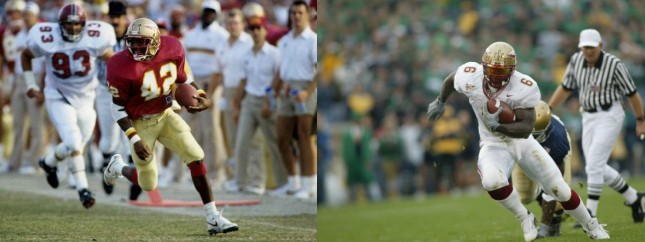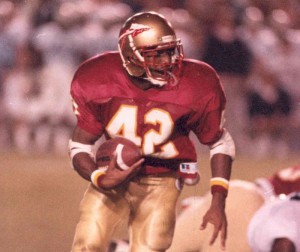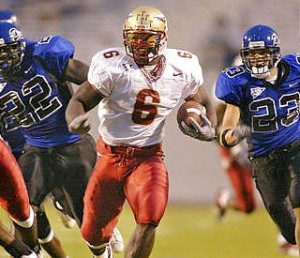Our most recent edition of Seminole Stand-Off focused on one pair of elite defensive ends who both left their mark on FSU football history. After all was said and done, it was concluded that Jamal Reynolds would be the pick over Björn Werner for his overall impact on both disrupting the pass and stopping the run. Noled Out readers conclusively agreed with the pick as Reynolds got 69 percent of all votes in the poll. We now look at two of the more underrated offensive threats in FSU history, who each had their own unique style of how to get it done on the ground.
Besides a couple of big names at the position, Florida State has not had many running backs become “legendary” players so to speak. Obviously guys like Warrick Dunn and Greg Allen exist, but they are the exception, not the rule. Most running backs at FSU are anywhere from serviceable to good, but there exists a few players who teeter on the brink of good and great. Usually, these borderline players were instrumental in helping FSU achieve success despite they themselves never having many personal accolades to cite.
Greg Jones and Amp Lee are two such players that have gone down in FSU fandom as being very influential on their respective teams without being considered the “star” players of such squads. Like Reynolds and Werner, Lee and Jones are separated by about a decade of time where Seminoles’ football underwent massive changes and overhauls to the program. Also like the former pair, Lee and Jones have similar career story lines that end up at the same question of: Just how good could they have been?
Yet even though they both may have questions surrounding their legacies, nobody would deny that each were extremely exciting to watch in their time. Lee and Jones both have their spot in fan memories, but this segment is focusing on a specific question — which would you rather have on your team?
The same rules will apply: A player’s NFL career will not be factored into our analysis — we are strictly looking at college performance/legacy. We will attempt to compare players from similar eras as well, meaning you probably won’t see a Fred Biletnikoff vs. Rashad Greene breakdown. Finally, team accomplishments will certainly have a role but we will try to isolate a single player’s impact in order to make it fair.
Amp Lee
Anthonia “Amp” Lee came to FSU in 1989 and immediately impressed everyone on the team with his pure athleticism and ability to contribute in both the running and the passing game. Even as a freshman, he was too good to keep off the field, which is why he got 61 attempts on the ground and 10 receptions in his first year with the team. Lee would only stay three years, but in those three years he became a fan favorite and carved out a unique spot in the Seminoles’ offense.
Despite only starting for two years, Amp still made his mark in the FSU record books. He is tied with Devonta Freeman for third most rushing touchdowns in Seminole history with 30, and had the second most rushing touchdowns in a single season with 16 in 1990. In total, Lee had 2,092 rushing yards, 30 rushing touchdowns, 968 receiving yards, and 8 receiving touchdowns. Once again…with only two years of starting reps. Amp was largely overlooked by publications, though a few did name him as an All-American in 1991.
As hard as it might sound to do, Lee was even more impressive on the field than his stats would indicate. It is honestly not that bold to claim that Amp was an almost Peter Warrick-esque prototype for the Seminoles. An amazing cutting ability combined with superb field vision made him a nightmare for other teams to bring down. The best display of these traits might have come in the 1991 FSU-Michigan match-up in Ann Arbor where Lee seemingly puts the whole defense on roller skates for a 44-yard touchdown run.
One thing about Amp that needs to be recognized is his propensity for showing up big in important games. His freshman year in 1989 saw Lee amass 138 total yards against 11th-ranked Auburn. In 1990, there were four games where FSU faced a top-25 opponent. Against those four opponents, Amp had almost 500 combined yards and seven touchdowns total.
That includes the rivalry game versus Florida where he had 147 yards and 2 touchdowns on the ground along with 43 yards and a touchdown through the air. FSU won that game 45-30. In his senior season, the Seminoles would face six ranked teams and Lee would play in five of them. In those five games, he accounted for 632 total yards and four touchdowns. Suffice to say, Lee knew what he needed to do to help his team win.
Some fans will always ponder on what Lee could have done if he stayed for his redshirt junior season. He got better every year and as mentioned above, had already etched his name into the FSU record books by then. It’s very possible that he would have become No. 1 in a lot of categories had he stayed.
Lee was a part of the Florida State teams that signaled a rise to the top of the college football totem pole. An overall record of 31-6 meant he never saw a team he was on finish below No. 4 in the AP poll. FSU won three straight bowl games including the Fiesta Bowl and Cotton Bowl.
Greg Jones
Unfortunately for Jones, he played for Florida State teams with the opposite trend. His first season was in 2000 when the Seminoles went to the national championship and his teams would only go downhill from there. Yet despite his bad luck, Jones would become another fan favorite due to his bruising running style and workhorse nature that allowed him to persevere in college.
This same workhorse nature helped him garner the sixth most rushing yards in FSU history with 2,535 and the eighth most rushing touchdowns with 23. His contributions in the receiving game were minimal (153 yards in four years) but that’s because the offense he played in relied on him to punish defenders on the ground instead of trying to fake them out of their cleats. In 2002, he was named second team All-ACC even though he had only played 10 games.
However, that still doesn’t make many feel better about Jones’ career. It was in 2002 that he blew out his knee during a phenomenal season that would have vaulted him into the national spotlight. Through 10 games, he had 938 rushing yards and 8 rushing touchdowns with a 5.8 yards-per-carry average.
Jones was a man amongst boys on the field; he was the result of what happens when someone puts a player’s Madden ratings at 99. His 2002 performance against Clemson with 165 yards and three touchdown on a 7.5 yards-per-carry average was capped off by what looks to be a bulldozer on a football field scoring a touchdown.
Of course, we’d be remiss if we didn’t mention the one play from Jones that has him forever immortalized in FSU history. Against North Carolina in 2003, Jones broke to the outside on a run around midfield. UNC’s safety Dexter Reid, who would be a fourth round pick in the upcoming draft, ran up and tried (unsuccessfully) to bring him down. He was instead given one of the nastiest stiff arms witnessed in college football to this day.
For Amp Lee, the “What if?” question emerges due to him leaving early for the NFL draft. For Greg Jones, the question is much more disappointing because it was not by his doing. His injury was truly unfortunate and he was just never the player he was beforehand. Yet despite this, Jones is still fondly remembered by Florida State fans, whether it be for his plethora of jaw dropping runs or his relaxed personality that became widely known around campus. While we won’t factor in his NFL career, it’s encouraged to go and read about how he fought through his injury troubles to become yet another fan favorite in Jacksonville.
The 2000 to 2003 Florida State Seminoles compiled a record of 38-14 with three BCS bowl appearances but only one bowl win — the Gator Bowl following the 2001 season. One wonders how different the 2002 Sugar Bowl would have been if Jones was healthy, but the result remains — a 26-13 Georgia victory.
Who’s The Choice?
Amp Lee would run around you. Greg Jones would run through you. Amp Lee was relied upon to be dynamic. Greg Jones was relied upon to be the backbone of the ground game. Amp Lee left early to go to the NFL. Greg Jones stayed all four years.
The differences abound in the Lee-Jones comparison, so much that it is almost personal preference as to which one you choose. Lee was absolutely electric — every time he touched the ball there was a serious chance he would score. Jones on the other hand, was liable to plain truck over any defender if he got going. Jones has more rushing yards and a higher yards-per-carry average, but Lee has many more receiving yards and total touchdowns.
Both are still well known to most fans and both will be remembered as extremely fun players to watch. We could spend all day arguing how valuable each running style is to their teams, but the goal of the position is to score. With this in mind, Amp Lee seems to be the best choice for a team. Jones may have been a more “pure” running back, but Lee had a nose for the end zone. Whether it was behind the offensive line or streaking across the field, Lee made defenses pay for not keeping track of him.
Florida State would not see a better athlete than Lee for a while. Because of his dynamic offensive arsenal and still impressive records, Amp Lee is the selection.
Do you agree with the pick? Let us know on Twitter or Facebook or the comments below. If there’s any match-up you want to see dissected, make sure to mention it as well!






















